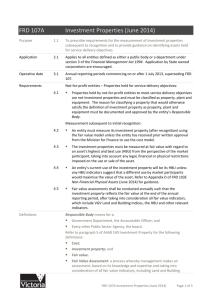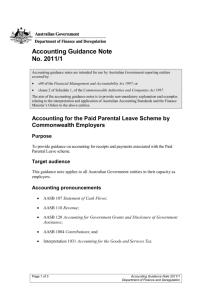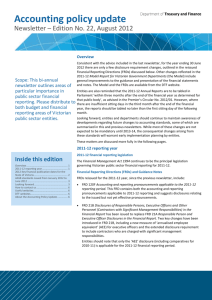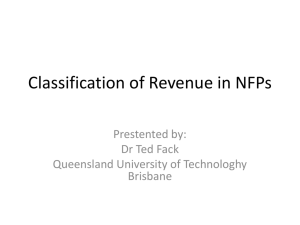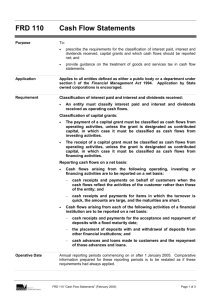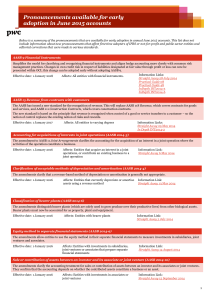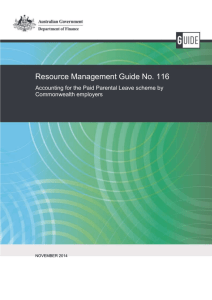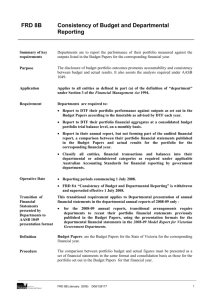Accounting policy update - Issue No. 28 - July 2015
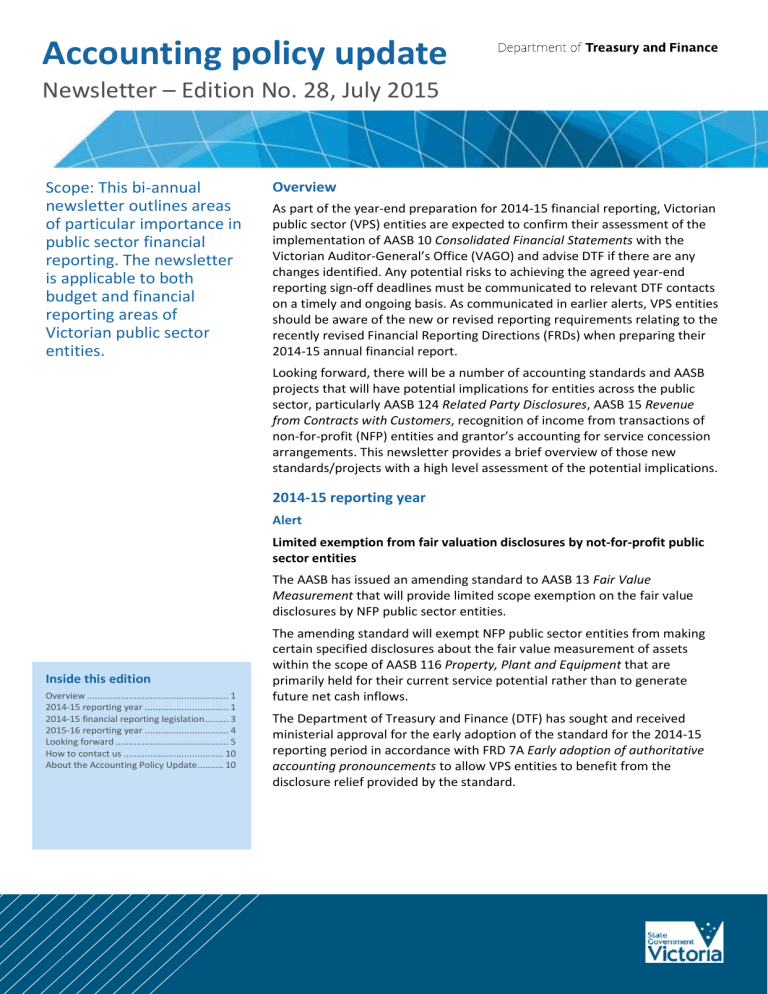
Accounting policy update
Newsletter – Edition No. 28, July 2015
Accounting policy update
Newsletter – Edition No. xx, Month 2013 newsletter outlines areas
As part of the year-end preparation for 2014-15 financial reporting, Victorian
of particular importance in
public sector (VPS) entities are expected to confirm their assessment of the implementation of AASB 10 Consolidated Financial Statements with the
public sector financial reporting. The newsletter is applicable to both budget and financial
Victorian Auditor-General’s Office (VAGO) and advise DTF if there are any changes identified. Any potential risks to achieving the agreed year-end reporting sign-off deadlines must be communicated to relevant DTF contacts on a timely and ongoing basis. As communicated in earlier alerts, VPS entities
reporting areas of
Victorian public sector entities.
should be aware of the new or revised reporting requirements relating to the recently revised Financial Reporting Directions (FRDs) when preparing their
2014-15 annual financial report.
Looking forward, there will be a number of accounting standards and AASB projects that will have potential implications for entities across the public sector, particularly AASB 124 Related Party Disclosures, AASB 15 Revenue
from Contracts with Customers, recognition of income from transactions of non-for-profit (NFP) entities and grantor’s accounting for service concession arrangements. This newsletter provides a brief overview of those new standards/projects with a high level assessment of the potential implications.
2014-15 reporting year
Alert
Limited exemption from fair valuation disclosures by not-for-profit public sector entities
The AASB has issued an amending standard to AASB 13 Fair Value
Measurement that will provide limited scope exemption on the fair value disclosures by NFP public sector entities.
The amending standard will exempt NFP public sector entities from making certain specified disclosures about the fair value measurement of assets within the scope of AASB 116 Property, Plant and Equipment that are primarily held for their current service potential rather than to generate future net cash inflows.
Inside this edition
Overview ...................................................... 1
2014-15 reporting year ................................ 1
2014-15 financial reporting legislation ......... 3
2015-16 reporting year ................................ 4
Looking forward ........................................... 5
How to contact us ...................................... 10
About the Accounting Policy Update.......... 10
The Department of Treasury and Finance (DTF) has sought and received ministerial approval for the early adoption of the standard for the 2014-15 reporting period in accordance with FRD 7A Early adoption of authoritative
accounting pronouncements to allow VPS entities to benefit from the disclosure relief provided by the standard.
Fair valuation of non-financial physical assets
In June 2015, DTF issued FRD 103F Non-financial Physical Assets to clarify the application of economic obsolescence when a non-financial physical asset is measured at fair value using the cost approach. It states that no adjustment for economic obsolescence should be made to the value of a non-financial physical asset if the asset is still in use. This FRD is applicable for the 2014-15 reporting period.
Further guidance has also been included to clarify the consideration of highest and best use of an asset when it becomes surplus.
In addition, DTF, in partnership with the Valuer-General Victoria (VGV), has developed a set of valuation guidance to ensure consistent valuation practice across the state. This guidance is not intended to replace FRD 103F, but rather provide a supplementary guide to FRD 103F. The guidance will be distributed to all CFOs and located on VGV website once it has been finalised with VAGO.
2014-15 Model Report for Victorian Government Departments
(2014-15 Model Report)
DTF released the 2014-15 Model Report in mid-April 2015.
The key changes compared with the 2013-14 Model Report include:
implementation of the reporting requirements of the suite of accounting standards which comprise AASB 10, AASB 11 Joint Arrangements and
AASB 12 Disclosure of Interests in Other Entities;
implementation of
Public Accounts and Estimates Committee
(PAEC) recommendations and guidance in the Report of Operations in relation to performance reporting, which have also been reflected in FRD 8C
Consistency of Budget and Departmental Reporting and FRD 22F Standard
Disclosures in the Report of Operations (as referred later in this newsletter); and
implementation of agreed VAGO recommendations (mainly editorial improvements).
Financial Report Directions (FRDs) and guidance notes
Since the last newsletter, several FRDs have been amended and are applicable for the 2014-15 reporting year. These FRDs include:
FRD 8C Consistency of Budget and Departmental Reporting (April 2015) requires a more detailed explanation for significant or material variances to budgeted financial performance;
FRD 22F Standard Disclosures in the Report of Operations (April 2015) requires additional disclosures on an entity’s key initiatives and progress, workforce inclusion policy and reporting occupational health and safety measures, and performance against those measures;
FRD 29A Workforce Data Disclosures in the Report of Operations – Public
Service Employees (April 2015) clarifies the reporting requirements for graduates;
Page 2
Accounting policy update, Newsletter – Edition No. 28, July 2015
FRD 30B Standard Requirements for the Publication of Annual Reports
(April 2015) reflects the requirement in Standing Direction for the rounding of monetary amounts in financial statements and revised printing specifications;
FRD 103F Non-financial Physical Assets (June 2015) states that no adjustment for economic obsolescence should be made to the value of a non-financial physical asset if the asset is still in use;
FRD 113A Investments in Subsidiaries, Joint Ventures and Associates in
Separate Financial Statements (June 2015) requires an entity to seek
Ministerial approval for an exemption from presenting consolidated financial statements. It also provides additional guidance to clarify when an entity can present separate financial statements subject to Ministerial approval; and
FRD 120I Accounting and Reporting Pronouncements applicable to
the 2014-15 Reporting Period (June 2015) updates the accounting standards and other pronouncements applicable for the 2014-15 reporting period and those that are issued but not yet effective for the current period.
The following FRDs have been withdrawn as they are no longer relevant:
FRD 19 Private Provision of Public Infrastructure (BOO/BOOT); and
FRD 101 First-time Adoption of Australian Equivalents to International
Financial Reporting Standards.
2014-15 financial reporting legislation
The Financial Management Act 1994 continues to be the principal legislation governing VPS financial reporting for 2014-15.
Other guidance
Superannuation Guarantee Levy
The Superannuation Guarantee Levy (SGL) schedule has been updated in accordance to the Minerals Resource Rent Tax Repeal and Other Measures
Act 2014 (the Act) passed in September 2014. Based on the Act, the future
SGL rates will remain at 9.5 per cent for seven years, before making yearly increments of 0.5 per cent from 2021 to 2025.
Departments and entities should use the new SGL schedule when estimating and measuring their employee benefit liabilities and expenses for financial reporting and future budget estimates. The table below outlines the new SGL rates for the financial years starting from 1 July 2014 to 1 July 2025, with the previous SGL schedule included for comparison.
New SGL schedule Old SGL schedule
Date
(per cent)
1 July 2014
1 July 2015
1 July 2016
9.50
9.50
9.50
9.50
10.00
10.50
Page 3
Accounting policy update, Newsletter – Edition No. 28, July 2015
Date
1 July 2017
1 July 2018
1 July 2019
1 July 2020
1 July 2021
1 July 2022
1 July 2023
1 July 2024
1 July 2025
New SGL schedule
(per cent)
Old SGL schedule
9.50 11.00
9.50
9.50
11.50
12.00
9.50
10.00
10.50
11.00
11.50
12.00
12.00
12.00
12.00
12.00
12.00
12.00
Wage inflation and discount rates
The wage inflation and discount rates are published quarterly (monthly in the last quarter of each financial year), to assist entities in ascertaining their financial position for the year-end. The rates for 30 June 2015 were published on the DTF website on 1 July. The rates for 30 September 2015 will be published on the DTF website at the beginning of October.
2015-16 reporting year
2015-16 Model Report for Victorian Government Departments
(2015-16 Model Report)
DTF is planning the release of the 2015-16 Model Report in April 2016.
Updates to the Model Report will include illustrative examples in response to new and revised accounting standards and applicable FRDs. In addition, consistent with previous practice, DTF’s responses to the recommendations from PAEC and VAGO will also be considered for illustration where appropriate.
More detail regarding proposed updates and changes for the 2015-16 Model
Report will be communicated in the January 2016 newsletter when the Model
Report is closer to finalisation/ministerial approval.
Page 4
Accounting policy update, Newsletter – Edition No. 28, July 2015
Key financial publication dates for the State of Victoria up to 2015-16
The following table shows the indicative key publication tabling dates for some of the State’s upcoming financial publications.
Reporting year
Publication Anticipated release dates – actual dates to be confirmed
2014-15 Annual Financial Report Anticipated for the end of September
2015. Legislated due date is 15 October
2015.
2014-15 Department and entity reporting
Expected to be tabled progressively on or before the last sitting day in
September 2015.
2015-16
2015-16
September Quarterly
Financial Report
Budget Update
Legislative due date is 15 November
2015.
Legislative due date is 15 December
2015.
Legislative due date is 15 March 2016. 2015-16 Mid-Year Financial
Report
2016-17 Budget papers Anticipated date is 3 May 2016, with a potential change to a later date subject to government discretion.
2015-16 Annual Financial Report Anticipated for the end of September
2016. Legislated due date is 15 October
2016.
2015-16 Department and entity reporting
Expected to be tabled progressively on or before the last sitting day in
September 2016.
Looking forward
Key AASB Standards issued but not effective for 2014-15
AASB 124 Related Party Disclosures
The recent amendment to AASB 124 Related Party Disclosures extend the scope of AASB 124 to mandatorily require all NFP entities to disclose related party information in the same way as private sector entities for reporting periods commencing from 1 July 2016.
Currently VPS entities at the departmental and entity levels are required to comply with the disclosure requirements of FRD 21B Disclosure of
Responsible Persons, Executive Officers and Other Personnel (Contractors with
Significant Management Responsibilities) in the Financial Report. The amendments to AASB 124 would override the disclosure requirements of
FRD 21B.
Page 5
Accounting policy update, Newsletter – Edition No. 28, July 2015
Compared with the current requirements of FRD 21B, the new requirements of the amended AASB 124 would:
potentially widen the scope of key management personnel (KMP) to the
Ministers who are ultimately responsible for the entities;
extend the scope of remuneration disclosure to include termination benefits;
require all related party transactions to be disclosed, with a partial exemption for transactions between government related entities of the same jurisdiction; and
require more disaggregated information about KMPs’ total compensation and more extensive data collection.
While comparatives will not be required in the first period to which these changes apply, VPS entities will need to give prompt consideration to the requirements of the amended standard, including identifying whom the new disclosure requirements would apply to, what related party transactions are likely to be material, and what information systems are needed to ensure that all the necessary supporting information is captured.
In light of the potential implications of this standard, DTF is planning to conduct consultation workshops to engage all relevant stakeholders to identify the implications of the new requirements and the necessary processes required to capture the information.
AASB 15 Revenue from Contracts with Customers
Following the International Accounting Standards Board (IASB)’s release of
IFRS 15 Revenue from Contracts with Customers, the AASB has issued
AASB 15 Revenue from Contracts with Customers in December 2014. In
May 2015, the IASB proposed amendments to IFRS 15 to defer the effective date from 1 January 2017 to 1 January 2018. AASB 15’s effective date is also likely to be deferred.
The core principle of AASB 15 is that an entity will only recognise revenue upon the transfer of promised goods or services to customers for an amount that reflects the consideration to which the entity expects to be entitled in exchange for those goods or services. Therefore, entities need to allocate the transaction price to each performance obligation in a contract to transfer goods or services and recognise the revenue only when the related performance obligation is satisfied. A potential significant impact will be the upfront recognition of revenue from licenses covering multiple reporting periods if there is no substantive continuing performance obligation.
VPS entities are encouraged to assess the extent of AASB 15’s financial and operational systems’ impact as early as practicable. For more detailed information of AASB 15 and its implications, please visit the DTF website for
Accounting Policy Update Newsletter Edition No. 27, January 2015.
The AASB has issued an exposure draft (ED) to provide implementation guidance for NFP entities to apply the requirements of AASB 15, as referred later in this newsletter.
Page 6
Accounting policy update, Newsletter – Edition No. 28, July 2015
AASB’s major domestic projects
Service concession arrangements: grantor accounting
The AASB recently issued ED 261 Service Concession Arrangements: Grantor based on the control approach of International Public Sector Accounting
Standard (IPSAS) 32 Service Concession Arrangements: Grantor, to address the lack of guidance in Australian Accounting Standards for accounting for service concession arrangements from the grantor perspective. Once issued as a standard, it would be applicable to all public sector entities.
The ED proposes that the grantor would recognise a service concession asset when it controls the asset. The grantor controls the asset if, and only if:
the grantor controls or regulates what services the operator must provide with the asset, to whom it must provide them, and at what price; and
the grantor controls – through ownership, beneficial entitlement or any significant residual interest in the asset at the end of the term of the arrangement.
The grantor would measure the service concession asset at its fair value in accordance with AASB 13 Fair Value Measurement upon initial recognition and AASB 116 Property, Plant and Equipment or AASB 138 Intangible Assets subsequently.
A corresponding liability would be initially recognised at the fair value of the service concession asset. The subsequent treatment is dependent on how the grantor compensates the operator in exchange of the service concession asset:
where the grantor has a contractual obligation to deliver cash or another financial asset to the operator, the grantor would account for the liability as a financial liability. The payments to the operator under the contract would be accounted for according to their substance as a reduction in the liability, a finance charge and charges for services provided by the operator; and
where the grantor grants the operator the right to earn revenue from third-party users or another revenue-generating asset, the grantor would account for the liability as the unearned portion of the revenue arising from the exchange of assets between the grantor and the operator.
Revenue would be recognised over the service concession arrangement period based on the economic substance and the liability reduced accordingly.
The main implications of the ED include:
earlier recognition of assets and liabilities of a service concession arrangement. Assets and liabilities would be recognised during the period in which the assets are constructed or developed if the proposed control criterion are met. This contrasts to the current practice of recognising assets and liabilities of a service concession arrangement only at the end of the construction period when the risks and rewards of ownership are transferred to the grantor; and
Page 7
Accounting policy update, Newsletter – Edition No. 28, July 2015
an increase in the recognition of assets and liabilities associated with a service concession arrangement which were previously not recognised.
Arrangements involving the grantor granting the private sector operator a right to earn revenue from a third-party user of the service concession asset is not currently recognised on the balance sheet. They would now have to be recognised as service concession assets and liabilities to the extent that the ED’s control criterion are met.
The proposed application date for the draft standard is 1 January 2017, with early adoption permitted. The ED is open for comments until 27 July 2015.
Income from transactions of not-for-profit entities
AASB recently issued ED 260 Income of Not-for-Profit Entities. The ED consists of two parts:
Part A: AASB 2015-X Revenue from Contracts with Customers – Australian
Implementation Guidance for Not-for-Profit Entities
Part A of the ED provides authoritative implementation guidance to assist
NFP entities apply the requirements of AASB 15.
According to the ED, a NFP entity would be required to first consider whether a transaction is a contract that has performance obligations. If it does, then
AASB 15 would apply and revenue would only be recognised when the performance obligation is satisfied.
It should be noted that if a NFP entity promises goods or services that are not part of an enforceable arrangement, or makes promises that are not stipulated in sufficient detail to be able to determine when they are satisfied, the transaction would not be in the scope of AASB 15 and then Part B of the
ED would apply. For example, where a charity has discretion over how donated money is used, or where a contract only specifies the period over which the grant money is to be expended but not the particular service to be delivered, there is no performance obligation, therefore income would be recognised as soon as it is received.
The ED also proposes to amend AASB 117 Leases such that NFP entities would be required to measure the leased asset at the fair value of the leased property at the inception of the lease, when there are indications that the consideration paid or payable is intentionally less than fair value. The difference between the asset’s fair value and the present value of the minimum lease payments would be recognised as donation income.
Part B: Draft AASB 10XX Income of Not-for-Profit Entities
Part B of the ED is a replacement standard of AASB 1004 Contributions. It addresses the accounting by NFP entities for the transfer of assets that do not arise from contracts that have performance obligations. Such transfers include, but is not limited to, voluntary transfers such as donations, grants, appropriations, and compulsory transfers such as taxes, rates, and fines. For these items, the draft AASB 10XX carries forward the current accounting treatment under AASB 1004, which requires recognition of an asset when the entity obtains control of the resource.
Page 8
Accounting policy update, Newsletter – Edition No. 28, July 2015
Main implications of the ED
The ED removes the reciprocal/non-reciprocal distinction under AASB 1004.
Instead, NFP entities would need to consider their funding arrangements and assess whether they fall within the scope of AASB 15 or draft AASB 10XX, or both, by assessing the existence of performance obligations. This assessment will involve analysing arrangements at a level of detail previously not required.
The main implications on the financial statements would include:
deferral in income recognition for non-reciprocal contracts that have performance obligations, compared with the current practice under
AASB 1004 of recognising income from a non-reciprocal transfer of assets once the entity obtains control of, or the right to receive, the asset; and
the recognition of the donation component in a lease contract as income immediately if identifiable and the initial measurement of the leased asset under a finance lease contract at its fair value. This may also impact the entity’s results on an ongoing basis due to the higher depreciation or amortisation expenses of these assets.
The proposed application date for the draft standard is 1 January 2017, with early adoption permitted. The ED is open for comments until 14 August 2015.
ED 260 is based on the principles of AASB 15. Accordingly, a deferral of the application date for AASB 15 (as referred earlier in this newsletter) would also potentially defer the proposed application date of ED 260.
The draft standard is expected to apply retrospectively. VPS entities are encouraged to review the proposals in the ED and assess the potential implications considering their own circumstances and arrangements.
Major international project
Leases
This is an IASB and Financial Accounting Standard Board (FASB) joint project to develop a new standard for both lessors and lessees, which would supersede the current requirements under IAS 17 Leases. The AASB issued
ED 242 Leases in 2013, which incorporated the IASB’s corresponding ED.
The ED proposes that most leases (with the exception of those with a term less than 12 months) would require the lessee to recognise a right-of-use asset and a lease liability at the commencement of the lease. Subsequently the lessee would recognise the unwinding of the discount on the lease liability and amortisation of the right-of-use asset.
For leases with a maximum possible term (including any options to extend) of 12 months or less, the lessee would be permitted to make an accounting policy election to apply simplified requirements that would be similar to existing operating lease accounting.
A key change is that most of those current operating leases will now need to be recognised on the balance sheet, with the subsequent unwinding of the liability discount and asset amortisation recognised in the operating statement.
The IASB is planning to issue the new leasing standard by the end of 2015.
An AASB equivalent standard is expected to follow.
Page 9
Accounting policy update, Newsletter – Edition No. 28, July 2015
Accounting Policy Update
ISSN 2205-4014
© State of Victoria 2015
You are free to re-use this work under a
Creative Commons Attribution 4.0 licence , provided you credit the State of
Victoria (Department of Treasury and
Finance) as author, indicate if changes were made and comply with the other licence terms. The licence does not apply to any branding, including Government logos.
Copyright queries may be directed to
IPpolicy@dtf.vic.gov.au.
How to contact us
AccPol mail box
When directing accounting policy enquiries to DTF at accpol@dtf.vic.gov.au
,
Departments are requested to support their questions with the facts and with clear referencing to Accounting Standards, FRDs and other authoritative pronouncements related to their queries.
Other entities are requested to contact their portfolio department in the first instance to resolve any accounting policy issues.
Useful websites
AASB – www.aasb.com.au
for information on AASB pronouncements, discussion papers and ED publications.
International Public Sector Accounting Standards Board (IPSASB) – www.ifac.org/ PublicSector for information on IPSASB and IPSASB pronouncements.
DTF website
The DTF website (for all internet users) – www.dtf.vic.gov.au
, covers FRDs and guidance, the Model Report, accounting policy updates, wage inflation and discount rates. From the menu on the top of the home page, users should select Government Financial Management, then Financial Reporting
Policy.
VPS users should contact their portfolio department in the first instance for the login details to access the information relating to the 2008 Long Service
Leave Model, the Valuer-General building and land indices.
For assistance with technical difficulties using the DTF website, e.g. broken links, please contact the DTF web team via email at dtfweb@dtf.vic.gov.au.
About the Accounting Policy Update
Accounting Policy Update is published by the Accounting Policy team of DTF twice a year. The aim of the newsletter is to highlight changes in financial reporting requirements affecting public sector entities, outlining any financial reporting related policy decisions reached by DTF and to inform readers of other developments that are under consideration by the AASB.
Disclaimer: No responsibility is taken for any action(s) taken on the basis of information contained in this newsletter nor for any errors or omissions in that information.
Page 10
Accounting policy update, Newsletter – Edition No. 28, July 2015

